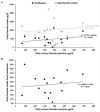Fluoride Intake Through Dental Care Products: A Systematic Review
- PMID: 35757442
- PMCID: PMC9231728
- DOI: 10.3389/froh.2022.916372
Fluoride Intake Through Dental Care Products: A Systematic Review
Abstract
Fluoride (F) is added to many dental care products as well as in drinking water to prevent dental decay. However, recent data associating exposure to F with some developmental defects with consequences in many organs raise concerns about its daily use for dental care. This systematic review aimed to evaluate the contribution of dental care products with regard to overall F intake through drinking water and diet with measurements of F excretion in urine used as a suitable biomarker. According to the Preferred Reporting Items for Systematic Reviews and Meta-Analyses (PRISMA) guidelines using keywords related to chronic exposure to F in the human population with measurements of F levels in body fluids, 1,273 papers published between 1995 and 2021 were screened, and 28 papers were finally included for data extraction concerning daily F intake. The contribution of dental care products, essentially by toothbrushing with kinds of toothpaste containing F, was 38% in the mean regardless of the F concentrations in drinking water. There was no correlation between F intake through toothpaste and age, nor with F levels in water ranging from 0.3 to 1.5 mg/L. There was no correlation between F intake and urinary F excretion levels despite an increase in its content in urine within hours following exposure to dental care products (toothpastes, varnishes, or other dental care products). The consequences of exposure to F on health are discussed in the recent context of its suspected toxicity reported in the literature. The conclusions of the review aim to provide objective messages to patients and dental professionals worried about the use of F-containing materials or products to prevent initial caries or hypomineralized enamel lesions, especially for young children.
Keywords: dental products; diet; drinking water; fluoride; toothpaste; urine.
Copyright © 2022 Saad, Escoube, Babajko and Houari.
Conflict of interest statement
The authors declare that the research was conducted in the absence of any commercial or financial relationships that could be construed as a potential conflict of interest.
Figures




References
Publication types
LinkOut - more resources
Full Text Sources

